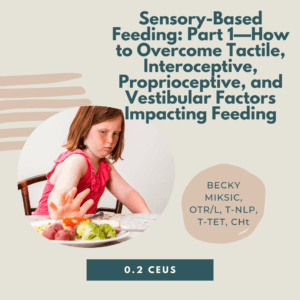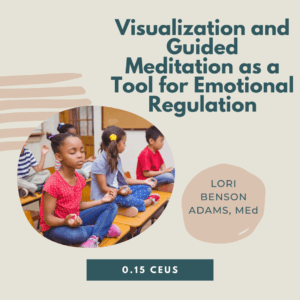Most primitive reflexes emerge in utero and naturally integrate by the age of three. Often that is not the case, especially with the growing use of containers (i.e., bouncy seats, jumpers, walkers) in infancy, lack of floor time, and pregnancy and birth trauma. Studies demonstrate a correlation between the increase of at least one primitive reflex in school-aged children and increased learning difficulties. This 6-hour, multi-speaker course focuses on five reflexes: MORO, Tonic Labyrinthine Reflex, Asymmetrical Tonic Neck Reflex, Spinal Galant, and Symmetrical Tonic Neck Reflex. Speakers address information from early intervention to school-aged children. Participants learn early identification of reflexes, functional activities to help integrate reflexes, rhythmic movements for integration, and testing and screening tools to use across various environments.
Sonia Story, BS, developed the Brain and Sensory Foundations curriculum to provide comprehensive training in the use of neurodevelopmental movements for addressing sensory, learning, physical, behavioral, emotional, social, and speech challenges. She authored a white paper and Evidence eBook with research and rationale for the use of neurodevelopmental movements in intervention. Sonia extensively studied innate neurodevelopmental movements with Harald Blomberg, MD; Moira Dempsey; Svetlana Masgutova; Mary Kawar, OT; and other instructors.
Sonia’s courses are approved for professional continuing education for occupational therapists, physical therapists, mental health counselors, myofunctional therapists, and massage therapists. She was a presenter at the 2018 Autism One conference on how innate neurodevelopmental movements help transform sensory issues. Her work has been featured in Almost Autism: Recovering Children from Sensory Processing Disorder; Special Ed Mom Survival Guide; Family Health Revolution; and Same Journey, Different Paths, Stories of Auditory Processing Disorder.
Rachel Harrington, COTA/L, AC, is a pediatric occupational therapy assistant, passionate about sensory integration, primitive reflexes, and early intervention. In October 2020, Rachel took over Sensational Brain, previously owned by Gwen Wild, MOT, OTR/L, in which she has rebranded and expanded into new courses, products, and more!
In addition to Sensational Brain, Rachel founded The Sensory Project, which shares simple sensory strategies and tips and handmade sensory tools on Etsy. She works part-time with Harkla to create sensory-related content for parents and therapists through a podcast, courses, and more.
Rachel is passionate about sharing her knowledge of sensory integration by participating in speaking engagements with nonprofit organizations, schools, childcare centers, and community events to increase early identification of sensory processing challenges.
Rachel lives in Boise, Idaho with her husband, two young children and golden retriever, where they are always hiking, exploring or spending time with family.
Kim Wiggins, OTR/L, is an experienced occupational therapist specializing in the treatment of children since 2001. She is a full-time therapist at a City School District in upstate New York, owner of OT Kim Wiggins, and has been a nationally known speaker since 2011. Kim is certified in Mobile Devices for Children with Disabilities, Puzzle Art Therapy, Handwriting Without Tears, Zaner Bloser, The Size Matters Handwriting Program, The Listening Program, and as an Irlen Screener. To view Kim’s courses, check out her product page.




© Sensational Brain 2024 – All rights reserved
This site is protected by reCAPTCHA and the Google Privacy Policy and Terms of Service apply.